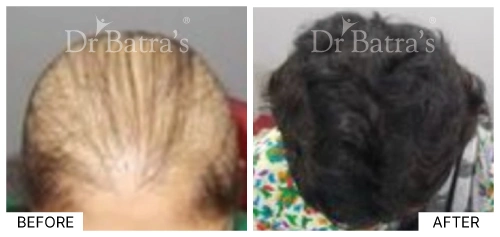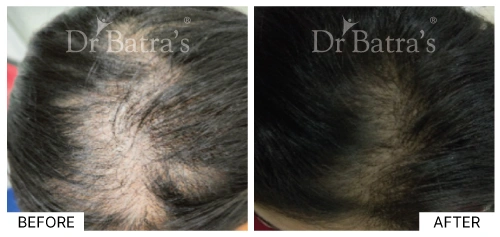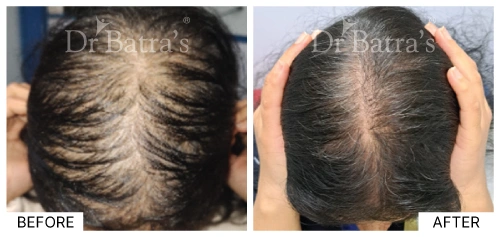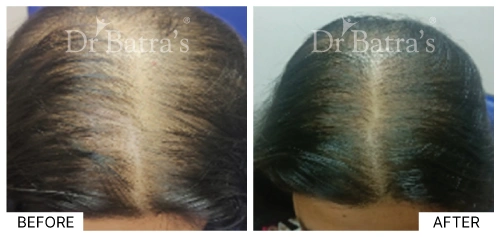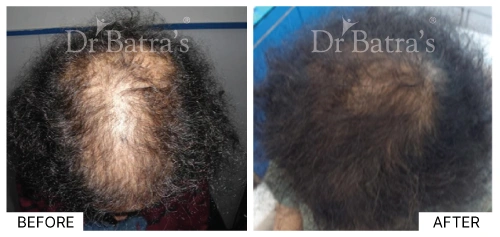Female Pattern Baldness Causes
Androgenetic alopecia, commonly known as female pattern baldness, is women's predominant form of hair thinning. It is characterised by hair thinning on the scalp, particularly in the top and crown areas. Female pattern baldness manifests as bald spots while maintaining the receding hairline seen in Male Pattern Baldness. Additionally, it results in a broader part and an overall reduction in hair density.
- Female Pattern Baldness Causes
- Cause of Hair Fall in Women (FPB)
- Psychological and Emotional Factors in Female Pattern Baldness
- Other Potential Factors in Female Pattern Baldness
- How common is female pattern baldness?
- Is Female Pattern Baldness Reversible
- Complementary to Medical Treatment Option
- Homeopathy and Female Pattern Baldness
- FAQs
Understanding the reasons behind hair thinning in women is crucial in addressing this concern. Statistics from the American Academy of Dermatology indicate that 50% of women may experience female pattern baldness by age 80. Genetic and hormonal factors play a significant role in sensitivity to the hormone dihydrotestosterone (DHT), contributing to the thinning or miniaturisation of hair follicles. This sensitivity leads to the production of finer and shorter strands, contributing to hair loss in females.
Female pattern baldness can have a profound emotional impact, necessitating professional intervention to identify the underlying cause of hair loss in women. Consulting with dermatologists or specialised trichologists offers a pathway to manage and address the condition effectively.
Treatment options for female pattern baldness include topical minoxidil and oral medications. In rare cases, hair transplant surgery may be recommended. Women experiencing significant hair loss should seek guidance from healthcare professionals and opt for a tailored approach to address their specific circumstances and types of hair loss.
Cause of Hair Fall in Women (FPB):
Understanding the Reasons For Hair Loss in Women
Genetics:
Genetics is one reason for female hair shedding. Specific genes can influence the sensitivity of hair follicles to hormones, making some individuals more prone to hair loss. Understanding the hereditary component is crucial in comprehending the onset and progression of FPB.
Hormonal Imbalance
Fluctuations in hormone levels, particularly estrogen and testosterone, contribute to major female baldness reasons. Hormonal imbalances can impact the hair growth cycle, leading to increased hair shedding and reduced follicular vitality. Exploring these hormonal dynamics is key to understanding the causes of hair shedding in women.
Dihydrotestosterone (DHT)
Dihydrotestosterone (DHT) is a potent hormone that shrinks hair follicles, resulting in thinning hair. Understanding the mechanisms by which DHT affects follicular size and function provides essential insights into the progression of FPB.
Medical Conditions
Female Pattern Baldness (FPB) is associated with various medical conditions. Thyroid issues are one common link. Hair loss in women with PCOS is prevalent. Several autoimmune disorders are frequently linked to FPB.
Investigating the connections between these health issues and FPB sheds light on the mixed nature of female hair loss. PCOS and baldness are particularly noteworthy in understanding the reasons for hair loss in females.
Stress
Stress exerts physiological effects on hair growth and extreme hair loss in women. Understanding the relationship between stress hormones and the hair follicle cycle is crucial. It comprehends the impact of stress on FPB.
Nutritional Deficiencies
Deficiencies in essential nutrients like iron and vitamin D can adversely affect hair health. It contributes to the development of thinning hair and PCOS. Briefly highlighting the role of nutrition in maintaining optimal hair condition adds a comprehensive dimension to understanding FPB.
Other Potential Causes
In addition to genetic and hormonal factors, ageing, scalp infections, and exposure to environmental toxins can also contribute to hair loss in females. Recognising these diverse influences is essential for a holistic approach to addressing and managing female hair shedding.
Understanding the multifaceted reasons for thinning hair in females requires consideration of various factors, including hair loss caused by genetic and hormonal factors and other environmental and health-related causes.
Psychological and Emotional Factors in Female Pattern Baldness
Emotional Impact:
Female Pattern Baldness (FPB) can have a profound emotional impact, affecting physical appearance and mental well-being. The visible changes in appearance caused by hair loss may lead to feelings of self-consciousness, embarrassment, and even anxiety or depression. Understanding the emotional toll of FPB is crucial for a holistic approach to managing this condition.
Body Image
The changes in physical appearance resulting from FPB can significantly impact body image. Women may struggle with accepting their altered appearance, leading to feelings of dissatisfaction and insecurity.
Social Interactions
Hair loss can also affect social interactions, as women may feel self-conscious about their appearance. This may lead to avoidance of social gatherings or activities, further exacerbating feelings of isolation and loneliness.
Self-esteem:
The visible signs of hair loss can profoundly affect self-esteem. Women with FPB may experience a decline in confidence and self-worth as they struggle to accept their changing appearance. Addressing these emotional aspects is vital for comprehensive care.
Psychological Effects
The psychological effects of FPB can extend beyond self-esteem to impact overall quality of life. Many women experience heightened stress and emotional distress as they cope with the challenges of hair loss. Integrating mental health support into treatment for female hair loss is essential for promoting well-being throughout the FPB journey.
Quality of Life
Hair loss can significantly impact the quality of life, affecting various aspects such as social interactions, self-esteem, and overall happiness. By addressing the psychological effects of FPB, healthcare providers can help women improve their quality of life and better cope with the challenges of hair loss.
Mental Health
The effects of FPB on mental health extend beyond self-esteem. Some individuals experience heightened stress and emotional distress. The treatment that integrates mental health while treating female hair loss is essential. It promotes well-being throughout the FPB journey.
It's crucial to recognise that treating FB extends beyond medical interventions. Addressing psychological factors is equally essential for a well-rounded approach to care. Supporting individuals emotionally can enhance their overall quality of life and contribute to a more positive experience during the management of FPB.
Self-esteem
Anxiety and Depression
Women with FPB are at increased risk of experiencing anxiety and depression due to the emotional toll of hair loss. Providing access to mental health support can help women cope with these feelings and improve their overall well-being.
Psychological Effects
The psychological effects of FPB can extend beyond self-esteem to impact overall quality of life. Many women experience heightened stress and emotional distress as they cope with the challenges of hair loss. Integrating mental health support into treatment for female hair loss is essential for promoting well-being throughout the FPB journey.
Other Potential Factors in Female Pattern Baldness
Female pattern baldness, or androgenetic alopecia, is a common condition that affects many women. It typically manifests as diffuse thinning on the crown of the head. The factors that cause it can be broadly categorised as lifestyle choices, scalp health, and environmental influences.
Lifestyle Factors
-Use of Hair Care Products
The types of hair care products used can significantly impact hair health and are among the causes of hair fall in women. Many women use shampoos, conditioners, and other styling products that contain harsh chemicals, such as sulfates, parabens, and alcohol.
These substances can strip the hair of its natural oils, leading to dryness, breakage, and hair loss. Additionally, frequent dyes and bleaches can weaken the hair shaft and make it more prone to damage. Choosing products with natural or gentle ingredients can help maintain hair health and reduce the risk of hair loss.
-Styling Practices
Styling practices, including heat tools and tight hairstyles, are significant causes of baldness in women. Regular blow dryers, straighteners, and curling irons can damage the hair cuticle and cause breakage, a major cause of hair fall.
Similarly, hairstyles that pull tightly on the hair, such as ponytails, braids, or buns, can lead to traction alopecia, a type of hair loss caused by chronic tension on the hair follicles. To minimise damage, it is advisable to limit heat tools, use heat protectant sprays, and opt for looser hairstyles.
Scalp Health
- Hygiene
Maintaining good scalp hygiene is crucial for healthy hair growth and preventing causes of female baldness. An unclean scalp can accumulate sebum, sweat, and product buildup, which can clog hair follicles and inhibit hair growth. Regular washing with a mild shampoo helps keep the scalp clean and debris-free.
- Conditions
Several scalp conditions are major causes of hair fall in women. Conditions such as seborrheic dermatitis, psoriasis, and fungal infections can cause inflammation and disrupt the normal hair growth cycle, leading to extreme hair loss in women.
Treating these underlying conditions is essential to prevent further hair loss. Over-the-counter treatments, prescription medications, and natural remedies can help manage these conditions and improve scalp health.
Environmental Factors
-Pollution
Environmental pollution is a growing concern for hair health and a known cause of hair fall in women. Pollutants such as dust, smoke, and chemicals can settle on the scalp and hair, leading to oxidative stress and weakening the hair shaft.
Prolonged exposure to these pollutants can cause inflammation and damage hair follicles, resulting in hair loss. Protective measures, such as covering the hair outdoors and using anti-pollution hair care products, can help.
-Climate
The climate can also influence hair health and contribute to female pattern baldness, including frontal balding. Extreme weather conditions, such as excessive heat, cold, humidity, or dryness, can affect the hair and scalp.
Hot and humid weather can increase sweating and sebum production, while cold and dry conditions can cause the scalp to become dry and flaky. Both scenarios can disrupt the hair growth cycle and cause hair loss.
How common is female pattern baldness?
Female pattern baldness, also known as androgenetic alopecia, is a prevalent condition affecting a significant proportion of women. It's estimated that up to 40% of women will experience some degree of hair loss by age 50, and the prevalence increases with age. By the time women reach their 70s, approximately 50% will deal with some form of hair thinning or baldness.
Unlike male pattern baldness, which often presents as a receding hairline and balding at the crown, female pattern baldness typically manifests as a general thinning of the hair, particularly on the top and crown of the scalp. In contrast, the frontal hairline often remains intact.
The condition is influenced by genetic factors, meaning that women with a family history of androgenetic alopecia are more likely to experience it themselves. Hormonal changes, particularly those related to menopause, can also trigger or exacerbate female pattern baldness. It's a condition that can cause significant emotional distress due to the societal emphasis on hair as a symbol of femininity. This emphasises the importance of knowing things that control hair fall and cure it.
Is Female Pattern Baldness Reversible
Whether female pattern baldness is reversible is complex and depends largely on the stage and severity of hair loss, as well as the underlying causes of hair fall in women. Currently, there are treatments in homeopathy that can slow down or even partially reverse the hair loss process.
Complementary to Medical Treatment Option
Emphasising the importance of addressing psychological factors alongside medical treatment is key. Integrating counselling, support groups, or therapy into the overall care plan can enhance the effectiveness of medical interventions and foster a more resilient mindset in individuals facing FPB.
Holistic Approach
Taking a holistic approach to FPB involves recognising the interconnectedness of physical and emotional well-being. Combining medical treatments with emotional support can empower individuals to navigate the challenges of FPB with greater resilience and a more positive outlook.
Support Systems
Establishing robust support systems, professionally and personally, is crucial for those experiencing FPB. Encouraging open communication about emotional challenges and providing resources for coping strategies can contribute significantly to overall mental health and well-being.
Homeopathy and Female Pattern Baldness:
Homeopathy offers an effective hair growth treatment for Female Pattern Baldness (FPB), characterised by specific hair loss patterns, especially for patients with conditions like Polycystic Ovary Syndrome (PCOS). Homeopathy can help by treating root causes like hormonal imbalances with personalised care.
How Homeopathy Addresses Hair Loss?
- Comprehensive Homeopathic Consultation: The process commences with a thorough analysis of one's medical history, lifestyle, and emotional experiences associated with hair loss. Homeopaths identify triggers such as hormonal imbalances or stress, enabling them to customise a treatment plan with individualised remedies. Regular check-ins enable adjustments based on the patient's response. Homeopaths may also advise on lifestyle and diet changes. This holistic approach tackles physical and emotional aspects, ensuring effective treatment for Female Pattern Baldness.
- Personalised Root Cause Treatment: Homeopathy tailors treatments to individual cases. By addressing specific hair loss symptoms in women and hormonal imbalances it plays a crucial role in treating hair loss associated with PCOS.
- Understanding the Hair Growth Cycle: Homeopathic remedies target different phases of the hair growth cycle. They focus on the resting phase, where hair loss commonly occurs. Homeopathy helps maintain a healthy hair growth cycle by supporting follicles during this phase.
- Addressing Common Causes: Homeopathy tackles various common causes of baldness or hair loss, including genetic predispositions and hormonal fluctuations. Treating these underlying factors aims to prevent further hair loss and stimulate regrowth.
- Targeted Treatment for Bald Patches: Homeopaths can specifically select remedies to address bald patches and spots. This approach promotes targeted regrowth and enhances the overall appearance of the hair.
- Safe and Non-Invasive Hair Treatment: Homeopathy provides a non-invasive alternative to aesthetic hair treatments. It stimulates natural hair growth without surgical intervention and is free from side effects.
- Emphasis on Hair Care: Homeopathy underscores the importance of proper hair care. Prescribed remedies support overall hair health, ensuring that hair receives the nutrients for growth and strength.
- Addressing Stress-Related Hair Loss: Stress is one of the key reasons for hair fall in females.
Homeopathy addresses the impact of stress on hair health. It provides remedies that help reduce stress and promote a balanced mental state.
In Conclusion, homeopathy hair growth treatment is a promising and holistic option for treating FPB. It acknowledges the emotional impact of hair loss and focuses on personalised treatments for root causes.
Homeopathy safely supports hair growth and overall hair health by addressing hormonal imbalances and promoting the hair growth cycle, effectively complementing medical interventions. Consulting with a qualified homeopath offers a tailored approach, providing hope for hair loss patients.
Medically Reviewed
Qualification
-
B.H.M.S (Maharashtra University of Health Sciences)
-
FCHD (Fellowship in Homeopathic Dermatologist - Mumbai)
FAQs
What are the best treatment options to stop hairfall?
The best natural treatments to stop hairfall include improving your diet with nutrients like biotin, iron, and zinc, using essential oils like rosemary or lavender, and practising gentle hair care routines. Regular scalp massages can also stimulate blood flow to the hair follicles and address various causes of hair fall in women.
What causes women to lose hair?
Common causes of hair loss in women include genetics, hormonal changes, stress, and nutritional deficiencies. Hormonal imbalances related to menopause or conditions like polycystic ovary syndrome (PCOS) are major causes of hair loss in women. Identifying specific causes of hair loss is crucial for effective treatment.
What ailments cause hair loss, or are they the causes of hair fall?
Ailments like thyroid disorders, anaemia, and autoimmune diseases (e.g., alopecia areata) are significant causes of hair fall in women. Scalp infections and chronic illnesses can also lead to hair loss. Understanding the underlying illnesses that cause hair loss in females is essential for proper treatment.
Can a deficiency in Vitamin 'D lead to hair loss?
Yes, a Vitamin D deficiency can lead to hair loss. Vitamin D plays a crucial role in hair follicle health, and its deficiency is one of the causes of hair loss in women. Supplementing Vitamin D can help address this cause of baldness.
Will I lose my hair as my father did in his 30s?
Genetics play a significant role in hair loss, but female pattern baldness presents differently. While you may have a predisposition, other factors, including hormones and lifestyle, contribute to the causes of hair fall in women. Monitoring and early intervention can help manage hair loss.
Why would a female get a bald spot?
Frontal balding in women and bald spots can occur due to conditions like alopecia areata, traction alopecia from tight hairstyles, or androgenetic alopecia. Hormonal imbalances and stress are also common reasons for hair loss in women. Identifying specific causes of extreme hair loss in women is key to targeted treatment.
How do you grow hair on a bald spot female naturally?
To grow hair naturally on a bald spot female, use essential oils like rosemary or peppermint, practice scalp massages, and maintain a nutrient-rich diet. These methods address the causes of baldness and promote healthy hair growth.
What is the best homoeopathic treatment for female pattern baldness?
The best homeopathic treatments for female pattern baldness include remedies like Thuja Occidentalis, Sepia, and Natrum Muriaticum. These treatments address underlying causes of female baldness and promote overall hair health.
How do you activate hair follicles on the scalp?
To activate hair follicles on the scalp, use regular scalp massages, apply essential oils like rosemary and peppermint, and ensure a balanced diet rich in vitamins and minerals. These practices can address various causes of hair fall in women.
How do we reduce DHT in females naturally?
To reduce DHT in females naturally, incorporate foods rich in zinc, lycopene, and biotin, use saw palmetto supplements, and apply green tea extracts to the scalp. These methods help mitigate DHT, a major cause of hair fall.
